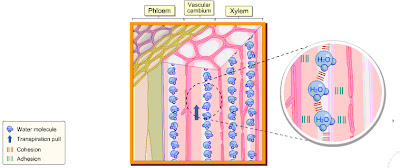Sunday, September 18, 2011
Monday, September 12, 2011
Transport of Water: Mechanism
1. Two theories to explain water + minerals transport in plants
- root pressure theory
- cohesion-tension theory.
2. Root-pressure theory:
- accumulation of mineral ions in the xylem
- enhances water molecules to move into root hairs (by osmosis).
- water pressure ↑ builds up in the root
- pressure pushes up water + dissolved minerals
- through the xlem
- toward the top of the plant.
3. In small plants:
- root pressure can build high enough
- to force water and minerals completely out of the tips of the leaves
- the process = guttation.
4. Cohesion-tension theory suggests that:
- water inside the xylem is pulled upward
- by the -ve pressure (or tension)
- that extends all the way from leaves to roots.
5. In the leaf xylem:
- -ve pressure (tension) builds
- as water evaporates during transpiration.
- evaporated water is continually replaced
- thus cohesive bond pull the string of water molecules up
- to create a transpiration pull.
- transpiration pull is relayed
- molecule by molecule
6. In the stem, water molecules:
- exist as a long unbroken chain in the xylem.
- are pulled upwards by tensions produced (during transpiration).
7. Transpiration pull:
- can extend down to the roots
- only through an unbroken chain of water molecules.
8. At the cellular level:
- the gradients of water potential
- drive the osmostic movement of water
- from cell to cell
Transport of Water: Concept
1. Dissolved substances (inside a plant cell) = contribute to solute potential (ψs).
2. More solute molecules present --> the lower is the water potential (ψ).
3. When water pontential is lower than> external solution:
- water molecules move into the cell .
- pressure inside the cell increases
- sell contents press against the cell wall
- create a pressure potential (ψs).
4. Water potential (of a plant cell) = solute potential + pressure potential.
5. Water potential = free energy of water.
6. By convention, water potential of pure water = 0 megapascal (MPa).
7. Water will move:
- from a region of higher (less -ve) water potential
- to a region of lower (more -ve) water potential.
8. In plasmolysed cell:
- pressure potential = zero
- water potential = solute potential.
9. As more water molecules enter a cell
- pressure potential ↑ increases
- so is its water potential ↑
- cell becomes turgid.
- less and less water molecules enter the cell.
10. Most minerals
- are actively transported into the root.
- there is a gradient of successfully
- lower water potentials from root hair to the xylem vessels
- result in water uptake by osmosis is enhanced.
11. Water moves by osmosis in the roots follows three pathways:
- apoplast
- symplast
- vacuole.
12. Apoplastic pathway:
- water travels along the cell wall
13. Symplastic pathway:
- water moves across the cytoplasm of one cell to the next
- across the plasma membrane
14. Vacuole pathway:
- water moves from vacuole to vacuole of one cell to the next
- across the plasma membrane
Subscribe to:
Comments (Atom)







